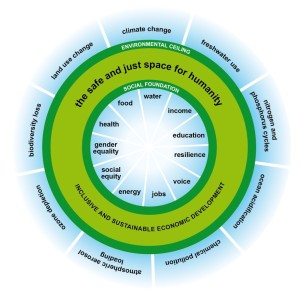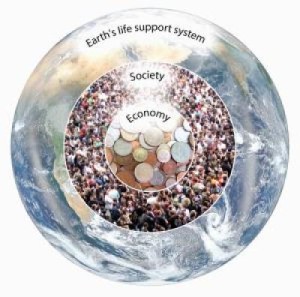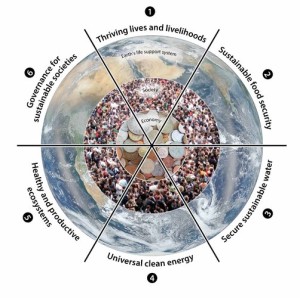The worthy UN process for consulting all interested parties on the content of the post-2015 Sustainable Development Goals (SDGs) received a bloody nose last week.
“Redefine sustainable development” was the blunt message of an influential group of earth scientists. The publication of their new paper, Sustainable development goals for people and planet, coincided with the Expert Group meeting on Science that took place in New York last Thursday and Friday.
This was the opportunity for the International Council for Science to engage with members of the UN’s Open Working Group that has been appointed to recommend SDGs to the UN General Assembly for 2013/14.
Earth scientists have never much cared for the political construct of sustainable development. They were disgusted by the omission of any reference to environmental limits, or planetary boundaries, in The Future We Want, the 50-page political outcome of last year’s much-hyped Rio+20 UN summit on sustainable development.
The outcome document’s presumption that independent voluntary commitments to sustainability by national and municipal governments, corporations and individuals will tidily aggregate to protect nature’s ecosystems is anathema to the scientific method.
In advance of Rio+20, the science lobby appeared to overcome its Achilles heel of poor communication, gaining ground for the case for science-based policy. A 2009 technical paper, Planetary Boundaries: Exploring the safe operating space for humanity, was brought to life by vivid graphics and by its media-friendly lead author, Johan Rockstrom, head of the Stockholm Resilience Centre.

The concept gained an unlikely ally in the shape of Oxfam, whose researcher Kate Raworth de-toxified the pure science by counterpointing planetary boundaries with social boundaries, the very necessary reminder that human dignity has its limits too. The strapline became the the safe and just space for humanity; the graphic gained a softer focus.
This promising momentum ran into the buffers of intransigence at Rio+20. However, the summit’s decision to move swiftly to articulate the SDGs offers the same group of scientists a second chance.
Their new paper rebrands the message in surprisingly aggressive fashion.
The surprise comes in abandoning the catch-phrase “planetary boundaries.” The nine boundaries threatened by anthropogenic activities, some of which are difficult to understand, have been merged into the more familiar concept of the “earth’s life support system.”
The aggression hits right where it hurts by attacking the treasured definition of sustainable development – development that meets the needs of the present, without compromising the ability of future generations to meet their own needs – which has stood firm since the 1987 publication of the landmark report, Our Common Future.
Going still further, the scientists want to dismantle the so-called three pillars of sustainable development, the mantra that the environment, social development and the economy should be awarded broadly equal priority in pursuit of the overall aim.

“They are not three equal pillars that you trade off. It’s in fact what we call a nested hierarchy; the big circle on the outside is the environment – think about how you’re going to live if the environment goes bad.” That’s the explanation offered by a signatory of the new paper, Professor Will Steffen (below), Executive Director of the Climate Change Institute at the Australian National University.
Professor Johan Rockstrom reiterates the message: “we are now at the point that the stable functioning of Earth systems is a prerequisite for a thriving global society and future development.”
If you think that sounds obvious, just reflect how it inverts the dictum of almost every world government, that “a thriving national economy is a prerequisite for social development and a stable environment.”
Will the new 2015 Sustainable Development Goals absorb this last-gasp reality check?
Not a chance. The refashioned message of the earth scientists doesn’t begin to address the reasons why the original planetary boundary approach failed at Rio+20.
It failed because we live in an unequal world and you cannot tell the poorer countries that their development aspirations are less important than restoring damage to the earth’s ecosystems caused by richer countries.
Nothing has changed since Rio+20. At the opening of the SDG Working Group’s proceedings last week, the UN Secretary-General called for “advancing economic, social and environmental objectives in a balanced and integrated manner.”
Many of the world’s poorest countries may go further and demand that social objectives should form that “big circle on the outside”, given that so many targets relating to Millennium Development Goals remain unfulfilled.
Whichever way you turn, the politics lines up against the dream of earth first, economy last.
The maddening truth is that the scientists are right. They’re telling us what we don’t want to hear because we have no political answer. They’re so right that I couldn’t help recalling the classic schooldays humour of W.C. Sellar’s 1066 and All That: A Memorable History of England. This is how it described the seventeenth century English civil war:
the utterly memorable Struggle between the Cavaliers (Wrong but Wromantic) and the Roundheads (Right but Repulsive)
The dilemma of our times is how to respond to the right but repulsive warnings of science.

In fairness, in their proposal for six sustainable development goals, the scientists are fully aware of the political imperative to end global poverty and hunger. Their matrix of environmental and human development targets seeks to finesse an Orwellian pact in which all goals are equal but some goals are more equal than others.
As an example, Johan Rockstrom suggests in his video presentation that targets to end hunger and to end environmentally unsustainable agriculture have equal force and relevance to achieving a sustainable development goal of food security.
Finessing objectives is the name of the political game and seems to me the wisest route for the earth science community. All the other components of this fresh assault on the totems of sustainable development feel superfluous and provoke my unsolicited advice.
I haven’t reproduced the scientists’ new definition of sustainable development because it isn’t new at all; it just adds more words to the old definition. And attacking the “three pillars” is too explicitly provocative for today’s hair-trigger politics.
I can’t see any fundamental flaw in the original concept of planetary boundaries, moulded into the Oxfam doughnut, nor any reason why emerging SDG ideas couldn’t be absorbed into it.
And please don’t publish important proposals about the SDGs behind a paywall! The UN is bending over backwards to ensure the process is transparent and open to all. There’s an increasing nucleus of key NGO leaders who refuse to speak at conferences which address papers that are hidden from public view.
Which reminds me – of eleven signatories to the paper published in Nature, I could detect only one from the development sector. Alliances with international development NGOs might give the earth scientists a little more traction in the slippery politics of sustainable development.
******
Sustainable Development Goals must sustain both people and planet from International Council for Science